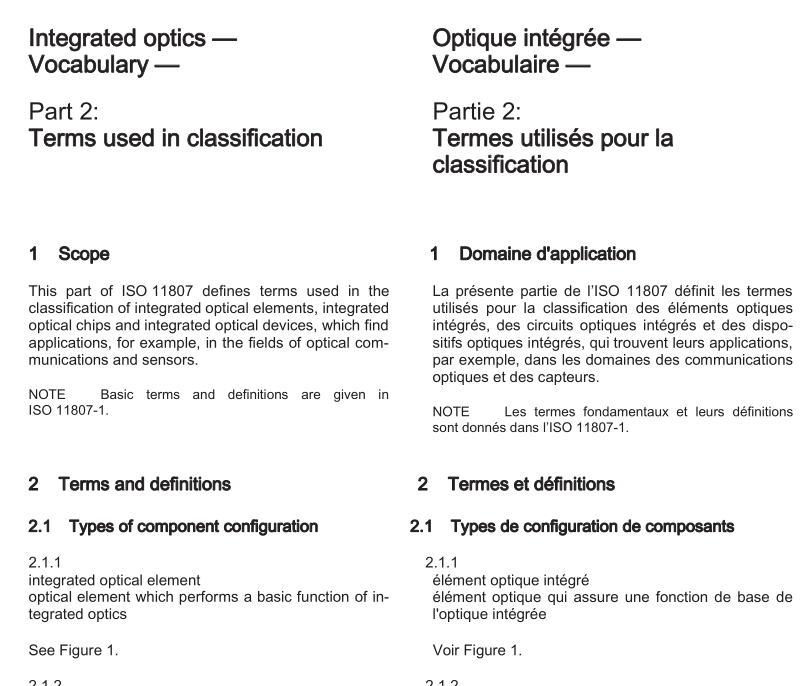BS EN ISO 11807-2 pdf download

BS EN ISO 11807-2 pdf download Integrated optics — Vocabulary — Part 2: Terms used in classification
1 Scope
This part of ISo 11807 defines terms used in the classification of integrated optical elements, integrated optical chips and integrated optical devices, which find applications, for example, in the fields of optical com- munications and sensors. NOTE Basic terms and definitions are given in ISO 11807-1.
2 Terms and definitions
2.1 Types of component configuration
2.1.1 integrated optical element optical element which performs a basic function of in- tegrated optics See Figure 1.
2.1.2 integrated optical chip monolithic unit which contains at least one integrated optical element See Figure 1.
2.1.3 integrated optical device packaged integrated optical chip NOTE The packaging may consist at a minimum of one optical input and/or output connection and/or electrical connections and/or a housing. See Figure 1.
2.2 Types of function
NOTE The types of function defined here are specified for elements, whereby they are valid for all corresponding component configurations.
2.2.1 passive integrated optical element element based on the principle of waveguiding and radiation interference, respectively, without external influence on the refractive index and ftted exclusively with optical inputs and outputs NOTE This element is employed for changing the di- rection, distributing, combining, transforming and filtering of guided radiation waves.
2.2.2 controllable integrated optical element element which can be influenced by various physical effects [e.g. electro-optical, acousto-optical, piezo- optical, thermo-optic or electro-absorptive material characteristics which can be used to change the (complex) refractive index]
NOTE In the case of electro-optical control, the refrac- tive index can be changed by the penetration of an electric field, or acousto-optical control by a surface acoustic wave (SAW).
2.2.3 active integrated optical element element based on photo-effect and emission
NOTE 1 Functions in this category include the genera- tion of optical signals (conversion of electrical signals into optical signals), amplification or detection (conversion of optical signals into electrical signals) of guided radiation waves.
NOTE 2 Included in this category are injection diode la sers, optical amplifiers and photodetectors integrated with waveguides.
2.3 Passive elements and chips
2.3.1 slab waveguide waveguide which confines the radiation only perpen- dicular to the substrate 2.3.2 strip waveguide element which confines the radiation in a two-dimen- sional cross-sectional area perpendicular to the sub- strate surface along a one-dimensional path NOTE In general the core or, in the case of a graded index profile, the corresponding core area, may be formed as:
embedded channel [see Figure 2a)]
or buried channel [see Figure 2b];
ridge on a substrate [see Figure 2c)];
ridge in a waveguiding layer [see Figure 2d)]
or rib on a waveguiding layer [strip-loaded waveguide; see Figure 2e)].
2.3.3 branch element which divides an input strip waveguide into multiple output strip waveguides
NOTE Depending on the application, a distinction is made between a divider usually a 1 ‘ M divider and a combiner, usually a N’ 1 combiner.
2.3.4 tap element which couples a given portion of radiation out of a strip waveguide into another waveguide branch- ing out of the side of the original waveguide









